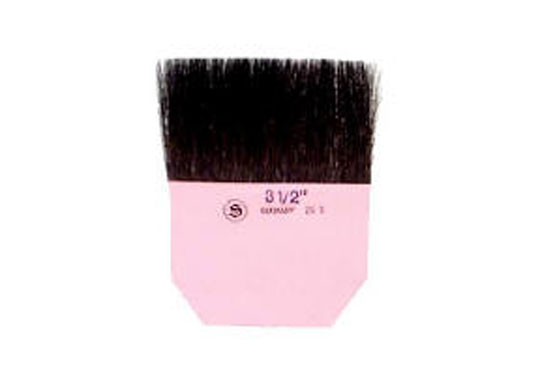Clearance and Close Out items! Reduced pricing on leaf, brushes and more. - Purchase Gift Cards
How to Gold Leaf with Water-Based Size
Modern water-based gilding method using acrylic adhesive size
Water-based adhesive sizes create a tacky bonding surface that securely adheres metal leaf to the substrate. Unlike traditional water gilding or oil size methods, water-based sizes are not burnishable, resulting in a naturally soft, satin to semi-gloss metallic finish.
With an exceptionally long open tack time, water-based sizes are ideal for large-scale interior projects, murals, ceilings, walls, signage, and production or manufacturing environments where extended working time and consistency are essential. This forgiving application window makes water-based size especially well suited for beginners, workshops, and high-volume gilding applications.
About Water based adhesive size
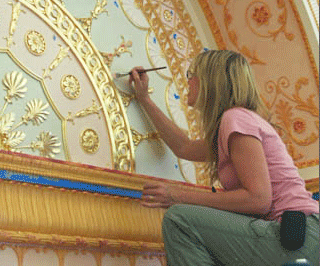
Aqua Size and Wunda Size are popular water based sizes and serve as an alternative to oil size for interior projects. Both have an extremely long tack time making it suitable for large scale interior projects or production gilding in manufacturing plants. Aqua Size and Wunda Size are most appropriate when used to gild with metal leaf, but will produce acceptable results with genuine gold. Porous surfaces should be sealed with A primer prior to sizing. Aqua and Wunda Size are for interior use only. Clean up as soon as possible with water or acetone.
Size refers to the adhesive material used to adhere gold, Silver, copper or metal leaf to the surface being gilded. There are different forms of size depending on the gilding method; oil based, water based and 'water gilding'. Gilding with water based adhesives should not be confused with traditional water gilding methods or the Kolner Water Gilding System. Water based adhesives form a tacky surface gluing the leaf to the surface and are not burnishable.
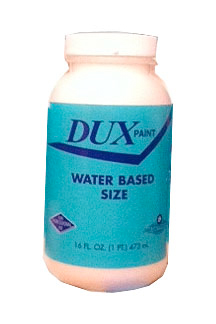
Dux AquaSize
Water based gilding adhesive
Dux Aquasize Size Dux Water Based Size is a clear, water-based adhesive formulated for all interior gilding projects. Purchase water based size.
| DWS/8
$ 12.95 Dux - Aquasize size. 8 oz. - 1/2 Pint - Coverage approx. 10 sqft |
Water based | |
| DWS/P
$ 17.00 Dux - Aquasize size. 16 oz - Pint - Coverage approx. 21 sqft |
Water based | |
| DWS/Q
$ 26.50 Dux - Aquasize size. 32 oz. - Quart - Coverage approx. 85 sqft |
Water based | |
| DWS/GAL
$ 88.00 Dux - Aquasize size. Gallon - Coverage approx. 340 sqft |
Water based | |
| DWS/5GAL
$ 382.00 Dux - Aquasize size. 5 Gallon Tub - Coverage approx. 1,700 sqft |
Water based |
Step-by-step tutorial starts here...
Step 1: Prepare work area. Cover working surfaces and floor areas with drop cloths or newspaper. Use low-tack painters tape to mask any areas not to be gilded. Lightly sand the surface if necessary with 220 grit sandpaper to remove any blemishes.
Step 2: Prime surface. When Gilding on objects or furniture, insure that the item is sufficiently primed with a water based primer. A can of spray primer provides the quickest solution for treating ornate items with hard to reach crevasses
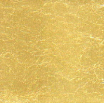
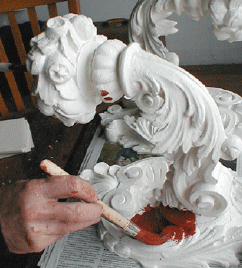
Step 3: Apply base color, also referred to as 'bole'. Once the primer is fully dry, you are ready to apply the base color for your leaf. For an 'old world' look, a rich earthy red color is used as a ground for both genuine and imitation gold leaf. For a comprehensive gilt appearance a yellow/ochre color is used. Select this base color tone carefully as you’ll be able to see some of this undercolor showing through on the finished gilt object. Use a brush or spray on this undercolr while paying attention to recesses and hard to reach places. You can experiment with different colors and your choice will affect the overall appearance of the finished product. Visit the Gilded Planet Bole color center for more color ideas.
Step 4: Apply adhesive 'size'. Size refers to the adhesive used to bond the leaf to a surface. A water-based gilding size works well for interior projects. Apply the size with a brush, working the size carefully, spreading it to an even film. Special attention should be used when working with objects that have deep recesses, insuring complete coverage of the size in these areas.
About Bole
This base color is also referred to as the 'Bole' color. Traditionally, bole was made from clay. Today paint is typically substituted. One can experiment with different colors and your choice will affect the overall appearance of the finished product. For example, the traditional terra-cotta color adds warmth to both gold and Silver leaf. A black 'bole' color creates a hard, cold look - often appropriate for Neoclassical, Art Deco pieces, and the like. A yellow 'bole' color evens out the overall appearance, and diminishes any 'holidays' or cracks on the gilded surface. You can learn more about true clay bole here.

Manetti 23kt Gold Leaf Books - 25 leaves
Manetti Brand - Italian Leaf Books. - 25 leaves. Each leaf is 3 3/8" x 3 3/8" square. Approx. coverage is 1.7 sqft. 16 gram weight per 1000 leaves.
| MA23.00SF/B
Manetti Brand - Gold Leaf Book |
Loose Leaf | |
| MA23.00PA/B Manetti Brand - Gold Leaf Book |
Patent Leaf | |
| MA23.00DB/B
Manetti Brand - Double Gold Leaf Book - 18 grams |
Loose Leaf | |
| MA23.00GL/B
Manetti Brand - Glass Gold Leaf Book - for gilding on glass |
Loose Leaf | More 23kt Gold Leaf - Packs, Books and Rolls |
Step 5: Testing your 'tack'. - Water based adhesive come to tack in approx. 20 mins and stay 'open' for up to 30 hours, allowing for a long open window to apply your gold leaf.
NoteWater based adhesive size sets up quickly and do not self-level. Therefore, you may experience brush strokes or roller marks drying in your adhesive and subsequently appearing in your finished gilt surface. For a smoother finish, consider using an oil based adhesive size, which self levels.
Step 6: Applying Gold Leaf:

Surface leaf: Placing a book of leaf in your hand, carefully fold back the protective paper to expose the gold leaf. Lay the leaf onto the sized area and 'roll' out the leaf. Hold firmly and carefully. Attach leaf to surface. The use of a 'Gilder's Tip' brush will greatly facilitate picking up a single sheet of loose leaf gold and allowing you to move the leaf to the sized surface.
Patent Leaf: Carefully remove a single sheet of gold leaf transfer paper and gently apply to your surface. Rub over the back of the paper with a gilder's brush, or gently with your fingers. Carefully remove the paper to leave the gold leaf adhered to the surface. Continue in this manner.
Step 7: 'Burnishing' or 'finishing off' the leaf - When using water based size, burnishing refers to the cleaning of the excess gold bits (Skewings) with a soft brush. Do not use an agate stone burnisher. Actual burnishing tools can only be used with Traditional Water GIlding Techniques. Learn more about Traditional Water Gilding here. Once leafing application is completed, remove all the extra, loose bits, known as ‘skewings’. Using the soft ¾ inch gilder’s brush, brush the surface removing any loose leaf flakes. Cotton balls may also be used. Do not use regular painter’s brushes, such as bristle or synthetic fibers, because they will scratch the leaf and dull the luster of the gold finish.
Step 8: Touching up 'holidays' in the leaf surface. Touch up any 'holidays', areas that are missing leaf due to lack of sufficient sizing or from leafed areas that may have torn away during burnishing. For details on this procedure visit the artSparx advanced gilding tutorials at the artSparx Gilded Corner.
Step 9: Seal and protect the gilded surface. Genuine Gold Leaf with a karat rating of 23kt or higher (23kt, 23.5kt, 23.75kt, 24kt) does not require sealing. However, it may be desirable to apply a protective coat of sealer to insure durability of the leaf, particularly in high traffic areas or for heavy use objects and furniture. Specially formulate for use over genuine or metal leaf surfaces, the 'Acrylic Topcoat' is a non-reactive, premium water clear sealer for genuine and metal leaf. Made from acrylic copolymers, Acrylic Topcoat provides protection from abrasion, water and ultra violet light. This solvent based sealer resists chemicals and may be applied by brush or spray. Available in Gloss and Satin finishes. More information.
Step 10: Apply antique glaze - OPTIONAL. Antiquing and aging your leafed surface adds character and old world charm. For antiquing recipes for gilded surfaces visit the Antiquing Center.

